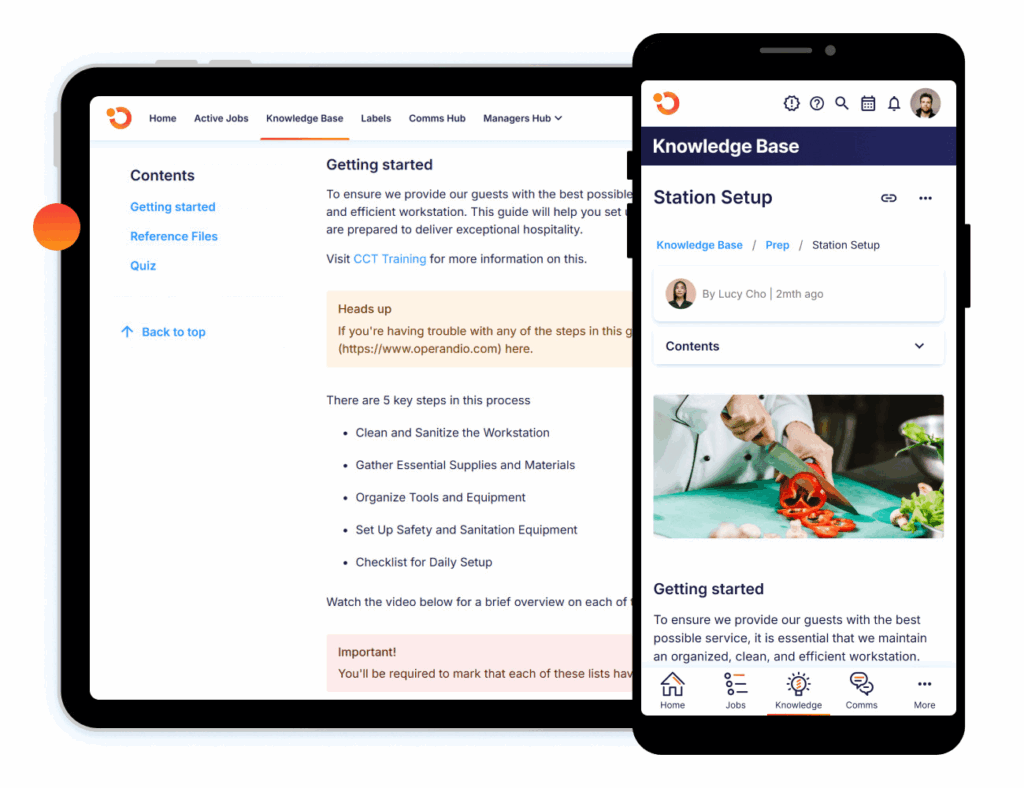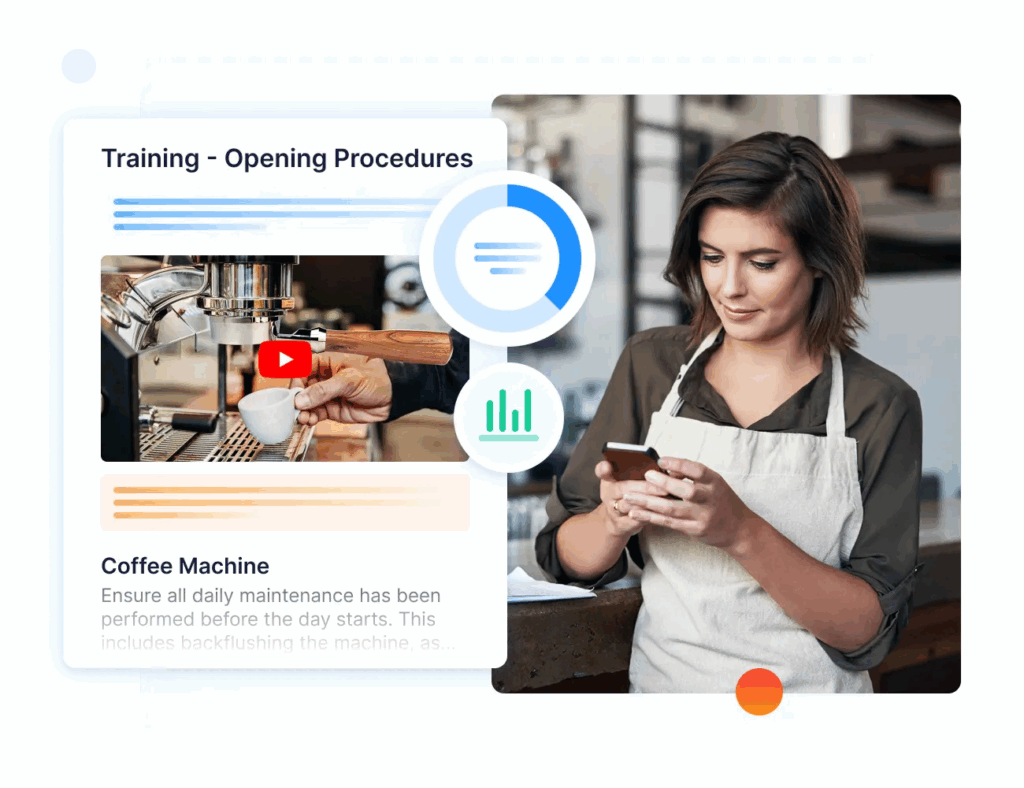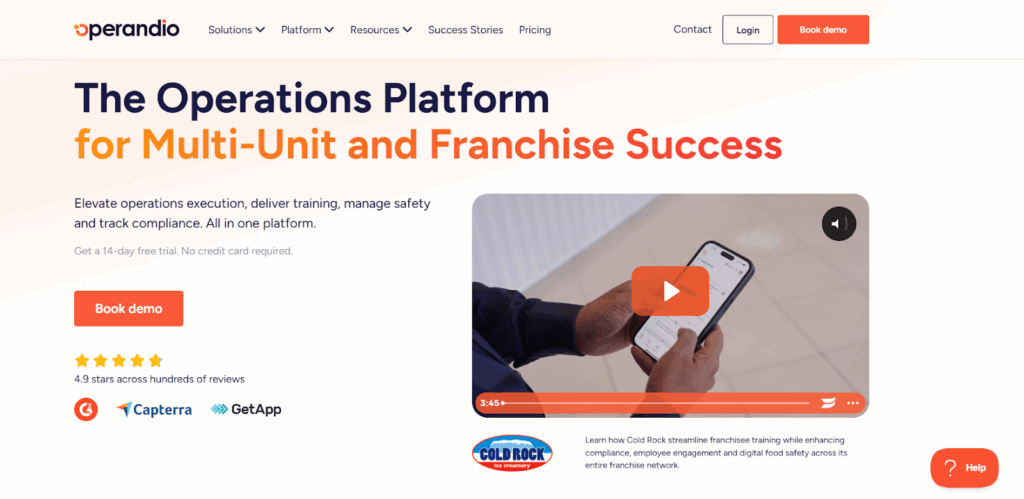Restaurant Management: Best Practices & Tips for 2026
Key Takeaways
- Senior managers in multi-unit restaurants need scalable systems that go beyond single-location fixes to keep standards consistent across every site.
- In 2026, rising staff churn and stricter compliance make one thing clear: restaurants that lack digital accountability and training systems stand a chance of falling behind.
- The most successful operators use integrated platforms to streamline labor, food safety, inventory, and customer experience.
- Digital operations software like Operandio reduces compliance risks and boosts efficiency, giving operators more control at scale.
Restaurant management in 2026 goes far beyond serving good food and keeping up with daily operations. The competition for strong leadership is intensifying.
As Rachael Nemeth, CEO and co-founder of Opus Training, puts it: “The market for skilled managers is likely to become increasingly competitive in 2026.”
For multi-unit operators, the challenge is even greater. What works at one location often fails across dozens of sites, teams, and compliance requirements.
This guide shares strategies to manage at scale, from digital systems that drive accountability to consistent training to technology that protects brand standards while cutting costs.
What is Restaurant Management?
Restaurant management is the coordination of people, processes, and technology to deliver consistent customer experiences while staying profitable and compliant.
In single-unit restaurants, this often means hands-on oversight. But in multi-unit operations, effective restaurant operations management depends on scalable systems that keep standards consistent without the manager being on-site.
Modern restaurant operations management uses digital tools for task tracking, compliance, training, and performance monitoring. The goal is clear: build systems that maintain accountability and consistency across every location.
Core Responsibilities of a Restaurant Manager
The core responsibility of a manager is to build scalable systems that improve restaurant efficiency, maintain consistency, and prevent compliance failures.
Staffing & Retention
Poor management drives high turnover, but strong leadership and culture reverse it. Standardized hiring, onboarding, and consistent development programs matter most.
Tools like employee training software ensure every team member receives the same high-quality training, reducing churn and improving performance across multiple locations.
Customer Experience
Guests expect the same service quality at every location. So managers must balance speed, hospitality, and consistency.
By applying proven strategies on how to improve restaurant operations, operators can track service quality, boost guest satisfaction, and ensure loyalty across their portfolio.
Food Safety & Compliance
Compliance grows complex with scale. Manual systems leave gaps, but digital solutions make oversight simple.
A digital food safety software platform automates HACCP logs, checklists, and audits, creating real-time alerts and audit-ready records.
This proactive approach protects your brand reputation and streamlines inspections.
Financial & Inventory Management
Profitability depends on real-time financial visibility. Centralized purchasing, cost tracking, and predictive analytics reduce waste and improve margins.
A restaurant inventory software system helps operators manage budgets, monitor labor costs, and control inventory across every site, ensuring consistency and growth.
Common Challenges in Restaurant Management
Understanding how to improve restaurant management requires identifying and addressing the specific challenges that multi-unit operators face. These obstacles often prevent restaurants from achieving consistent performance across all locations.
Challenge #1: Scalable Standard Operating Procedures
Most restaurant SOPs are built for single locations and fail when applied across multiple sites. The result is inconsistent standards from one restaurant to another, a major barrier to effective management at scale.
Solution: Develop digital SOPs and a comprehensive knowledge base with Operandio. Add decision trees for common scenarios and integrate with restaurant task management systems that track completion and provide real-time visibility into performance.

Challenge #2: Consistent Training Delivery
As restaurants scale, maintaining consistent training across locations becomes increasingly complex and costly. Without it, service standards drop, and standard procedures will get ignored.
Solution: Use Operandio’s restaurant learning management system. This platform improves employee training, tracks progress, and verifies staff competency across all locations, while cutting the cost and complexity of in-person programs.

Challenge #3: Compliance Verification and Reporting
Managing food safety compliance across multiple locations entails significant administrative work and increases the risk of violations, particularly due to varying local regulations.
Solution: Operandio digital compliance platforms automate temperature checks, cleaning verification, and reporting. They also flag issues early, helping you stay inspection-ready and consistent across sites.

Challenge #4: Real-Time Operational Visibility
Traditional management is often reliant on being on-site, which makes it challenging to oversee multiple locations and catch issues early.
Solution: Operandio’s Integrated dashboards provide real-time visibility into KPIs across all sites, enabling proactive decisions before problems impact customers or profits.

Top Restaurant Management Tips for Multi-Unit Success
These tips are designed for operators managing multiple locations. Each one addresses common challenges and provides clear steps to improve consistency, efficiency, and profitability.
Tip #1: Implement Predictive Management Systems
Strong managers stay ahead by planning for events like sports games, holidays, and festivals. At scale, this requires predictive systems that use historical data and external factors, like weather and seasonality, to forecast staffing, inventory, and scheduling needs.
This approach helps you prevent understaffing during rushes and overordering stock you don’t need.
Tip #2: Develop Location-Independent Leadership
Assistant managers and shift leads shape culture across every site. Build cross-training programs that expose them to different challenges and markets.
This creates adaptable leaders who can manage any location with consistency, document best practices in a knowledge base, so all managers have access to proven solutions.
Tip #3: Leverage Integrated Technology Platforms
Disconnected systems waste time and create errors. Instead, use platforms that integrate POS, inventory, scheduling, training, and compliance into one.
Integration reduces admin work, improves accuracy, and gives you real-time data to make better decisions.
Tip #4: Create Systematic Quality Assurance
You can’t be everywhere at once, but your organizational chart should make clear who owns quality at every level.
Digital audits, mystery shopping, and customer feedback tools provide managers with accountability and offer visibility across all sites. These systems help maintain consistent quality as you scale.
Tip #5: Build Data-Driven Decision Making
Stop collecting data for its own sake; instead, turn it into action. Predictive analytics can optimize labor, inventory, and menu planning across your entire portfolio.
Data-driven decisions ensure you respond faster to changes and operate more efficiently at every location.
Tip #6: Establish Community Integration Strategies
Restaurants don’t operate in isolation; they’re part of local communities. Give managers the tools to engage locally while staying aligned with brand values.
This builds customer loyalty and strengthens your reputation across markets.
How to Build Scalable Systems & Processes
Learning how to improve your restaurant management at scale requires fundamental shifts from location-specific frameworks to system-wide thinking.
And this systematic approach ensures consistent quality while maintaining operational flexibility.
Digital-First Standard Operating Procedures
Traditional paper-based SOPs fail at scale due to version control issues, accessibility limitations, and verification challenges.
But using digital SOPs is a game-changer. It is accessible via mobile devices, enabling you to track all location procedures and receive updates at will.
So learning how to create digital SOPs for your restaurant can help build these systematic approaches.
Advanced SOP Implementation Strategy:
- Create role-based access controls so team members only see relevant procedures.
- Build interactive checklists that require photo verification for critical steps.
- Include contextual help and troubleshooting guides within each procedure.
- Establish review cycles with location feedback to continuously improve procedures.
- Link SOPs directly to training modules for immediate skill development.
Centralized Training with Local Execution
Consistency in training is one of the biggest challenges in multi-unit restaurant management.
You need every employee, from the morning shift in Location A to the closing crew in Location Z, to deliver the same standard of service. At the same time, each location has its own scheduling realities, peak hours, and staffing needs.
That’s where restaurant-focused learning management systems (LMS) come in. They let you deliver standardized training content while giving local managers flexibility on when and how staff complete it.
The best systems also integrate with your scheduling and HR tools, so you can track certifications, verify competencies, and spot gaps before they affect service.
Automated Compliance Monitoring
Digital compliance platforms reduce the administrative burden of food safety management while improving consistency and accountability. These systems should automate routine monitoring tasks while providing comprehensive reporting for regulatory compliance.
Integrated Performance Analytics
Real-time dashboards that aggregate data from POS, scheduling, inventory, and compliance systems provide the visibility necessary for effective restaurant management.
So it’s best you focus on leading indicators that enable proactive intervention rather than reactive problem-solving.
Change Management and Adoption
As a senior manager or restaurant owner, scaling systems requires more than adopting trendy software and gadgets; it demands cultural transformation.
Successful implementation follows proven change management principles that ensure widespread adoption across diverse locations and teams.
Financial ROI Framework for Scalable Systems
Multi-unit operators need clear financial justification for system investments. Calculate ROI based on labor savings, compliance risk reduction, inventory optimization, and customer satisfaction improvements.
Key ROI Calculations:
- Labor efficiency gains from automated scheduling and task management.
- Food cost reductions through better inventory tracking and waste prevention.
- Insurance premium reductions can be achieved through improved safety and compliance records.
- Revenue increases from consistent customer experiences and faster service.
- Administrative cost savings from centralized reporting and management.
Pro tip: Plan for a 6-12 month gradual rollout rather than trying to transform everything simultaneously.
Building Smarter Restaurant Management With Operandio

Operandio provides multi-unit restaurant operators with a single platform to manage consistency, compliance, and daily performance across all locations. It combines task management, food safety tools, temperature monitoring, staff training, and performance tracking in a system built for restaurant operations.
From HACCP compliance and food prep labeling to centralized training and real-time task tracking, Operandio helps operators scale without sacrificing safety or quality.
What sets Operandio apart is its single platform approach, mobile-first design for frontline teams, automated compliance reporting, and scalable features for QSRs and fast-casual brands.
Ready to streamline your operations? Book a demo and see how Operandio helps restaurants cut costs, maintain standards, and keep every team accountable.


